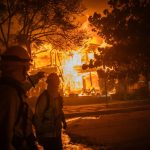The Department of Health also confirmed one more Victorian had died from the virus. Saturday’s total is the state’s highest daily figure of infections since the pandemic hit.Under the lockdown exit road map plan, released last week, a minor easing of restrictions was due to come into effect on Sunday if 80 per cent of Victorians aged 16 and older had received their first vaccine dose.As of Saturday morning, 76.3 per cent of the state’s population have received their first dose, while 46.57 were double dosed.It came a day after New South Wales recorded 1043 new Covid-19 cases and 11 deaths, the NSW Premier Gladys Berejiklian confirmed.The new deaths included five women and six men from a range of age groups. One was a man in his 50s from Broken Hill.The focus of concern is now shifting from Sydney’s west and southwest to the state’s Illawarra region with 103 cases recorded in the area overnight, Chief Health officer Dr Kerry Chant said.“The Wollongong local government area is the most impacted and the Shellharbour local government area,” Dr Chant said.“I urge everyone to be cautious. Come forward to be tested and also, please be vaccinated.”Fragments of Covid-19 were also detected in the sewage at Lightning Ridge in western NSW, Jindabyne in southern NSW, Crookwell in the Southern Tablelands, and South Lismore in northern NSW. Dr Chant said there had been no recent cases identified in these areas. Of Friday’s new cases 256 were from southwest Sydney, 211 from western Sydney, 107 are Sydney and 123 from the city’s southeast. The rest were from various parts of the state including the far west and Central Coast.While case numbers remain steady the state’s vaccination rate continues to grow with more than 56 per cent of the eligible population now fully vaccinated. The figure for first doses has now exceeded 84 per cent.NSW is expected to reach the 70 per cent double dose target on October 7 with ‘freedom day’ to come the following Monday, according to the Premier.The 80 per cent double dose milestone should be achieved ten days later.Though the Premier said she was reluctant to label the day restrictions ease ‘freedom day’ because the reopening plan would be done “cautiously” and “step-by-step”.‘We must remember that even though people may be fully vaccinated, if you are vulnerable and have other conditions you can still succumb and get the disease in a serious way, or worse,” Ms Berejiklian said.“While we are all looking forward, almost a gallop to the finish line in terms of the double dose, we need to make sure that what we do at 70 and 80 per cent is done cautiously and also moderately.”NSW Covid Exposure Sites‘GOING TO 1000’: GRIM WARNING AS VIC HAS 733 NEW CASESVictoria has recorded 733 new locally acquired cases on Friday as Melbourne’s sixth lockdown continues to have no affect on slowing surging infections.One new death was also announced by the health department on Friday, which takes the death toll of the outbreak to 21.The number of Victorians who have now lost their lives to Covid-19 stands at 841.Experts have warned that infections will continue to surge and Victoria will soon join NSW in recording daily increased above 1000.University of Sydney Professor Robert Booy said it was worrying and he fears Victorian cases are heading out of control.“It’s a worry, it’s not in control and it’s a real lesson to everyone else,” he told The Today Show on Friday.“I can see this going to 1000 just as NSW did – peaking at a largish number and falling again.“The go hard, go early approach hasn’t worked because Delta is such a foe.”Victoria’s chief health officer Brett Sutton has also warned infections haven’t peaked and will continue to rise.“We haven’t peaked unfortunately,” Professor Sutton said last week.“The risk of it getting to 1000 is real.“The modelling and everything we know in relation to our current vaccination coverage would suggest that cases will continue to increase – vaccination alone won’t mean that there’s a peak at the 400s.”The health department confirmed the 733 new locally acquired cases about 9am, which comes after the highest daily spike Victoria has seen since the start of the pandemic with 766 new infections announced on Thursday.The virus continues to spread rapidly through Melbourne’s northern and western suburbs with 83 per cent of new cases originating from those areas.About 84 per cent of all active cases in Victoria are people under 50 years of age, while almost a quarter of cases are people in their 20s.No new cases were recorded in hotel quarantine on Friday. More than 23,200 primary close contacts remain in isolation in Victoria.There are now 7160 active cases in the state.NED-3869-Covid-19-Exposure-Sites-VictoriaNED-4588-VIC-road map-out-of-lockdownQLD PREMIER CASTS DOUBT ON BORDER REOPENINGQueensland Premier Annastacia Palaszczuk has cast doubt on opening the state’s borders, saying lifting border restrictions ever after vaccine coverage reaches 80 per cent would be a “backward” step.Ms Palaszczuk did not say what Covid-19 vaccination threshold would need to be met to safely reopen to NSW and Victoria, adding a national reopening plan had “not been finalised”, The Australian reports.“If you look at the national plan, the 80 per cent actually takes you backwards and I do not want that for Queensland, so we’re probably going to see a difference for Western Australia and Queensland because at the moment we have freedoms,” Ms Palaszczuk said on Thursday.When asked about lifting health restrictions, she said she would need to see additional health modelling.“At the moment, Queenslanders have more freedoms now than Victorians will when they reach 80 per cent vaccinated,” she said. “In NSW, you have a massive Delta outbreak, so you have to go and ask the NSW government what is their plan for Christmas?”State and territory leaders in July agreed on a pathway to freedom, where fully-vaccinated Australians would be exempt from “all domestic restrictions” once 80 per cent of the population older than 16 was vaccinated.But Ms Palaszczuk said Queenslanders would enjoy more freedoms at home than if they travelled overseas.“Where are you going to go? Are you going to go to India? In Tokyo, you have to sit in perspex screens with masks on and if you remove your mask you can’t talk while you’re eating,” she said.National – 2021 – Covid Vaccination StatsBLOOD CLOTS LINKED TO ASTRAZENECA RISE TO 141 A further seven blood clots have been linked to the AstraZeneca jab – all in NSW.Two cases have been confirmed in 34 and 79-year-old men from NSW. Five cases in 54, 66, 71, 74 and 77-year-old men from NSW are being treated as probable.This take the total Australian reports assessed as blood clots or thrombosis with thrombocytopenia syndrome (TTS) following AstraZeneca to 141 cases (77 confirmed, 64 probable) from nearly 11.3 million vaccine doses.Eight people have died as a result of TTS – six of these were women. The figures were released in the Therapeutic Goods Administration Covid-19 vaccine weekly safety report on Thursday afternoon.The TGA reports most blood clots occurred about two weeks after vaccination. The risk of TTS after a second dose appears to be much lower than after the first dose.The TGA also reports that to 19 September, it has received 118 reports of suspected Guillain-Barre Syndrome (GBS) occurring after the AstraZeneca jab. GBS is a rare immune disorder affecting the nerves and can result in pain, numbness, muscle weakness and difficulty walking.In the same period, the TGA has received 77 reports of suspected ITP following vaccination, a type of thrombocytopenia or low platelet count. NED-3736-Vaccine-benefit-vs-harmThe TGA has also received eight reports of suspected myocarditis in adolescents aged 15-17 years to 19 September – seven boys and one girl – after the mRNA vaccines Pfizer and Moderna. Four of the cases occurred after the second dose. “None of these cases had sufficient clinical evidence to be classified as highly likely to be myocarditis (level 1). There were an additional 12 reports of suspected pericarditis not combined with myocarditis in this age group of which five were clinically consistent with pericarditis,” the report says.The TGA advises people should seek immediate medical attention if they develop any of the following symptoms after vaccination:– severe or persistent headache, blurred vision, confusion or seizures– shortness of breath, chest pain, leg swelling or persistent abdominal pain– unusual skin bruising and/or pinpoint round spots beyond the site of vaccination.The most common time period for onset of TTS symptoms is four to 30 days after vaccination.
Powered by WPeMatico





